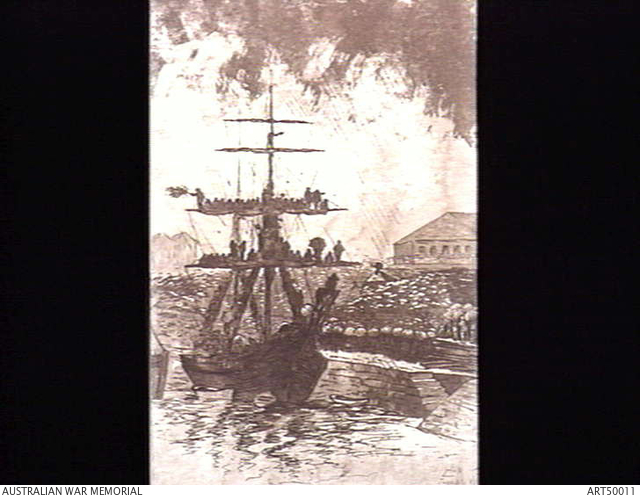| Places | |
|---|---|
| Accession Number | ART50011 |
| Collection type | Art |
| Measurement | Overall: 22.5 x 14.8 cm (plate); 31 x 21 cm (sheet) |
| Object type | |
| Physical description | etching with aquatint on paper |
| Maker |
Hopkins, Livingston |
| Place made | Australia: New South Wales, Sydney |
| Date made | 1885 |
| Conflict |
Sudan, 1885 |
| Copyright |
Item copyright: Copyright expired - public domain
|
Return of the New South Wales Contingent from the Sudan June 23 1885

Depicts the troop ship of the New South Wales Contingent, which had been involved in the War in Sudan returning to a wharf crowded with people to welcome them home. As it was raining heavily, the people are all sheltering beneath umbrellas and can't see anything (part of 'The Bulletin's' general debunking of the whole expedition). The illustration was by Livingston Hopkins (1846-1927) an influential painter, illustrator and cartoonist who worked for the 'Bulletin' and known as 'Hop', who came to Australia after a successful career in the US. Between March- June 1885, the NSW Contingent served in Sudan, Africa. The contingent, an infantry battalion of 522 men and 24 officers and an artillery battery of 212 men, was ready to sail on 3 March 1885. It left Sydney amid much public fanfare, generated in part by the holiday declared to farewell the troops; the send-off was described as the most festive occasion in the colony's history. The NSW contingent anchored at Suakin, Sudan's Red Sea port, on 29 March 1885 and were attached to a brigade composed of Scots, Grenadiers and Coldstream Guards. Shortly after their arrival they marched as part of a large "square" formation -on this occasion made up of 10,000 men - for Tamai, a village some 30 kilometres inland. Not having participated in any battles, Australian casualties were few: those who died fell to disease rather than enemy action. By May 1885 the British government had decided to abandon the campaign and left only a garrison in Suakin. The Australian contingent sailed for home on 17 May 1885, arriving back in Sydney on 19 June. It was generally agreed at the time that, no matter how small the military significance of the Australian contribution to the War in Sudan, it marked an important stage in the development of colonial self-confidence and was proof of the enduring link with Britain.
